
10 May After the Storm: Volunteering in the Philippines
Baby John-William was safely tucked inside his mother’s womb when the typhoon that killed his father hit their home in Tacloban six months ago. The day before the storm, locals say that the skies had been beautiful and clear; despite warnings to evacuate it seemed inconceivable that far out at sea the most powerful typhoon ever to hit land was brewing. In the early hours of the 8th November, Typhoon Haiyan – or Yolanda as she’s known to Filipinos – cut a deadly path towards the small island of Leyte and the house by the sea where John-William’s family were sleeping.
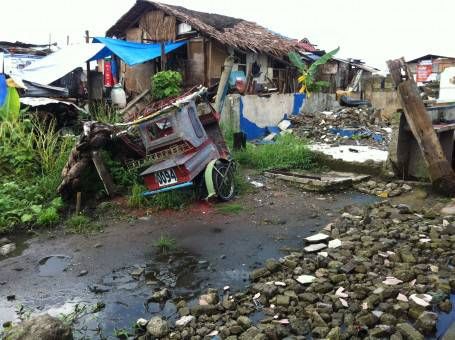
“The children were shaking their father; they didn’t understand that he was dead,” John-William’s Grandma tells us through tears, gesturing towards the spot where her son’s body was found after the 12ft storm surge and 195-mile-per-hour winds tore their house to the ground. She points to the jagged scars etched upon the scalp of her older grandson Jonathan, which were caused by falling debris – a life-long reminder of the storm that has changed their lives forever.
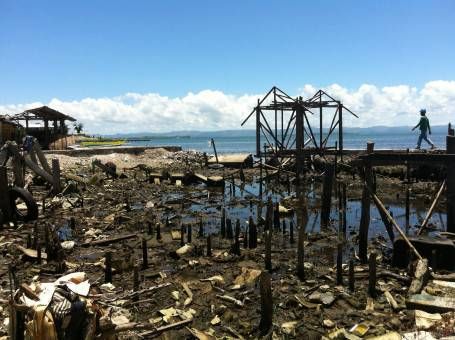
Now the family shelters inside a small, hastily-erected wooden house in the very same perilous spot their old one stood; typhoons are an annual occurrence in the Philippines and another one could easily wipe out their home for a second time. Survival is a daily struggle for a widow with no income and five children to look after; so much so that John-William’s mother was forced to consider giving up her baby – the last piece of her husband – for adoption. “The other children wouldn’t let him go, they knew their father wouldn’t want the baby taken away,” his Grandma tells us.
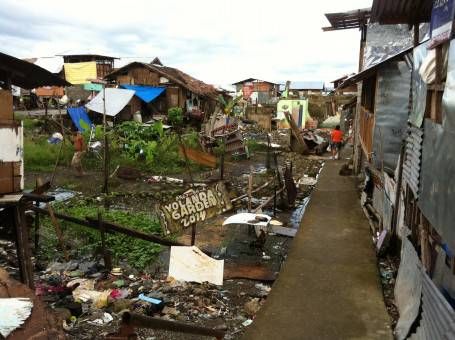
This is just one family’s story. Here in Tacloban, where up to 10,000 people were killed by Yolanda and around 90 percent of the city’s buildings were destroyed or damaged, there are countless more stories to be told and homes to be rebuilt. We are here to help clear the rubble left behind by the storm so that the people of Tacloban can begin to rebuild their lives.
Volunteering in the Philippines with All Hands
When news of Typhoon Yolanda reached us we were travelling in Laos. We watched the pictures of rubble-strewn streets and blank-eyed survivors searching for lost family members with the kind of muted, disconnected horror everyone feels when they’re seeing a disaster unfold from the other side of a TV screen. By coincidence, just days before the typhoon hit we had booked flights back to the Philippines, a country we had not long since visited and fallen head-over-heels for. We knew we couldn’t return to the country after it had suffered such a devastating disaster without offering our help, so we decided to volunteer with All Hands, an American non-profit organisation that helps victims of natural disasters around the world.
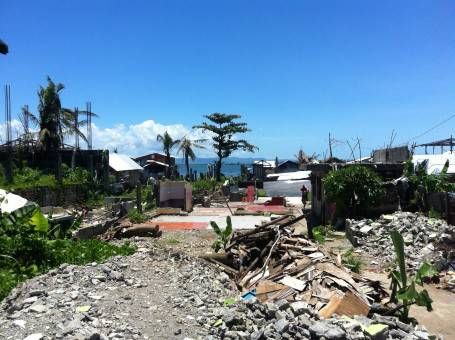
Almost exactly six months after Yolanda struck, we arrived in Tacloban City, one of the areas hardest hit by the storm. The evidence of this lay everywhere; from the rooftop of the All Hands base we could see the white Astrodome where homeless families lived for months after the typhoon. Huge ships washed inland by the storm surge served as incredible lasting reminders of Yolanda’s awesome power. As we rode to work in a jeepney on our first day, plots of land carpeted with rocks stuck out like missing teeth; a solitary wall or toilet the only reminder that each pile of debris used to be someone’s home.
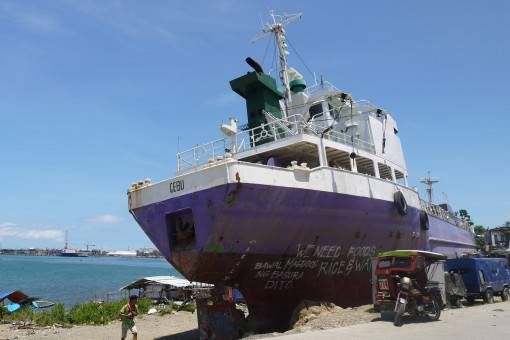
Along with around 50 other All Hands volunteers from around the world, we were working with the local council and Catholic Relief Service to help individual homeowners clear rubble and debris from their land and deconstruct the precarious remains of their houses. We worked with simple tools; spades, wheelbarrows, sledgehammers and saws, our bodies quickly became coated in sweat and dirt under the pulsing sun. Throughout our time in Tacloban temperatures exceeded 30 degrees and the humidity sapped our strength; we were sweating faster than we could take in water and our bodies ached with fatigue and stung with cuts and bruises – it was the most physically difficult work I’ve ever done.
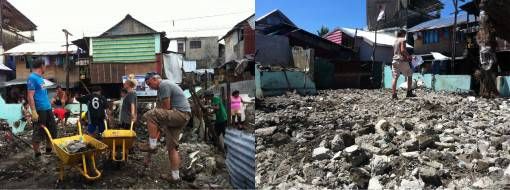
Clearing one plot of land – before and after
This type of volunteering can take an emotional toll on you too. Many people we met, like John-William’s Grandma, wanted to share their harrowing stories with us. Sometimes, whilst sorting through the debris I’d uncover items; a baby’s shoe, a water-damaged photo album, someone’s plastic ID badge, a broken ornament, a dog’s skull. Each discovery reminded me that this pile of rock used to be a home, a place where a family lived and loved. Even though All Hands assesses each site carefully to ensure there’s little chance of it happening, the idea that I might uncover someone’s remains amongst the wreckage always lurked in the very back of my mind.
The Challenges Ahead
Usually we worked in neighbourhoods right next to the sea, where the terrifying storm surge did the most damage. Many of these areas have now been declared ‘No Build Zones’ by the Government and a 40-metre line from the sea has been drawn to determine where homes can be rebuilt. Despite this, thousands of people remain in the ‘No Build Zones’, living in flimsy shelters made of wood, tin and tarpaulin. At first this shocked me, after everything they’ve been through, why don’t people just move to safer, higher land?
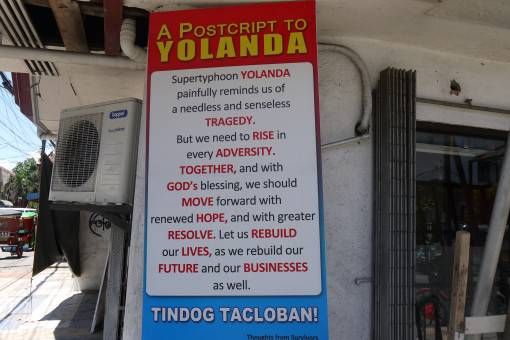
In time I came to realise that this isn’t as simple as it sounds. For a start, families who were already poor before the storm and now might have no income at all just cannot afford to move. Most people are on waiting lists to be relocated to the mountains, but they could be on those lists for years. Besides, even if they could move, many families don’t want to. For fishermen, their livelihoods depend on being based by the sea and those who work in the city don’t want to be miles away. At the heart of it all, the people in Leyte have a strong sense of community, they live in close-knit Barangays (neighbourhoods) and have done for generations; how can they leave that support network behind after everything they’ve already lost?
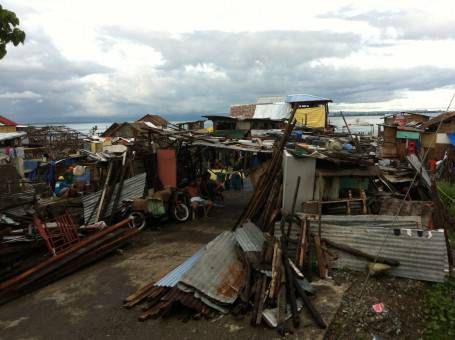
There are no simple answers to these problems. Despite the devastation Yolanda caused, Filipinos are used to weathering storms every year and they’re deeply religious people; churches were some of the buildings most swiftly rebuilt after Yolanda. We heard time and time again from the locals that they believe God will protect them if another storm comes – I doubt that this simple faith is enough.
The Beautiful People of Tacloban
Volunteering in Tacloban was physically and mentally tough – the fact that some All Hands volunteers have been working on the project for months on end absolutely blows my mind – but it was also one of the best experiences of my life. Removing the physical wounds caused by Yolanda may only be the beginning of the healing and rebuilding process but seeing the impact of our work made all the sweat and pain worthwhile. We were helping families to start afresh and in return, I learned a lot from the people of Tacloban.
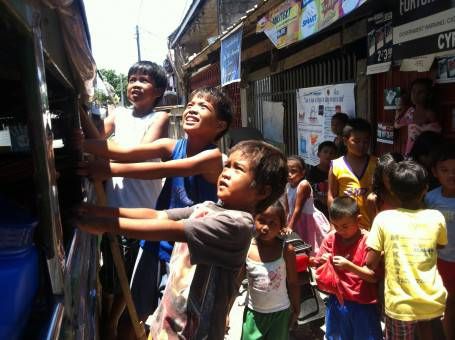
Even though they’ve lost so much in the storm, I was beyond awed by the resilience and kindness of the people in Tacloban. As we drove to work in our colourful jeepney people would wave and smile and kids would scream out Hellos. Often we’d start work as a handful of volunteers, but within hours locals would have stopped to help, chat or bring us snacks. These incredible people face life, despite its extreme hardships, with a smile. I hope that whatever challenges I face in the future I will do so with the same strength and grace – meeting these incredible people was a truly humbling experience.
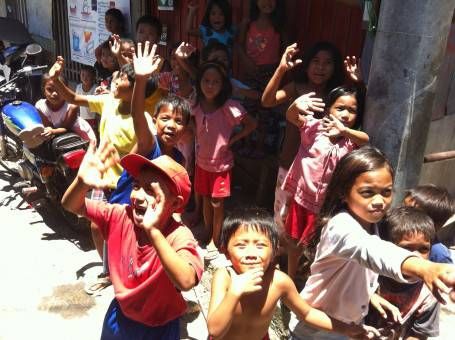
Above all else, there is hope to be found in Tacloban and it is most visible in the faces of the children I met there. I will never forget the hordes of smiling, bright-eyed children who would gather around to watch us work, eager to get their hands on our tools and join in. They were tough and savvy, collecting rebar from the wreckage to sell by the kilo but they were also sweet and curious, asking us endless questions and telling us we were beautiful even though we were covered in sweat and dirt.
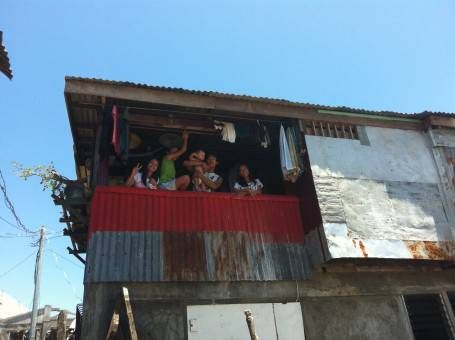
My favourite kids from Barangay 35A were a group of girls who would call out ‘Auntie Amy’ as I approached, tell me about their idol Taylor Swift, write me thank you cards and sing songs as I worked. One afternoon they came running over to show me a dead rat they’d found, I turned to see four-year-old Alex, who loved to roam around stark naked, proudly holding it by the tail.
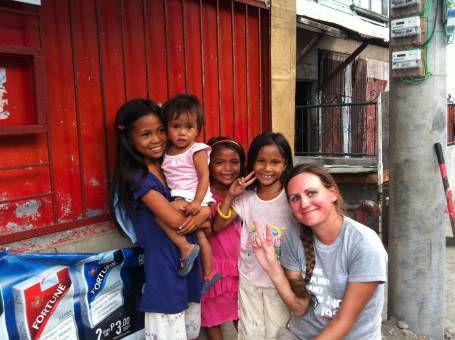
As we waited for our jeepney one afternoon a group of kids began spontaneously singing as they perched on top of a nearby trike, unselfconsciously shouting their words to the sky, clapping their hands and swinging their legs. They weren’t performing for us or anyone else, they were just singing for the sheer hell of it; I could have stood there and basked in their infectious energy for hours. This is my lasting memory of Tacloban: the indestructible spirit of the people.
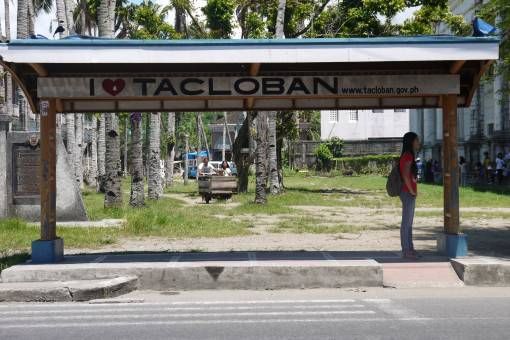
If you want to volunteer in the Philippines check out the All Hands website to find out how to get involved.
Sources: icyclone.com, the Guardian, All Hands, ReliefWeb





Katrina
Posted at 13:40h, 10 MayWow, what a great testimony. Thanks for sharing your experience and insight.
Amy
Posted at 14:38h, 10 MayThanks Katrina, it was an amazing and humbling experience; we hope to volunteer with All Hands again in the future.
Kellie
Posted at 14:08h, 10 MayThis was such an amazing thing to do. It sounds like it was really hard physical work though and I can only imagine that the emotional side was equally difficult too.
I always think the resilience and strength of some people is amazing, we have a lot to learn from them.
Amy
Posted at 14:36h, 10 MayIt was pretty tough Kellie but I kept reminding myself what the people of Tacloban have been through; we are so lucky that we don’t have such extreme weather in the UK. I am so awed by how resilient the people in Leyte are.
Rob
Posted at 18:13h, 12 MayIt’s a true testament to the human spirit. People can be so inspiring without even realising, they just carry on and keep smiling despite such devastation. It definitely humbles…
Amy
Posted at 02:29h, 13 MayThat’s true Rob, it is humbling. Volunteering in the Philippines was an amazing experience, one I’ll never forget.
Catherine
Posted at 22:21h, 12 MayWhat an honourable thing to do. IT sure does sounds like hard work, but it definitely sounds like it was worth it too. Love the fact that the kids were so energetic and inspirational to you. You’ve certainly inspired me to look into this sort of volunteering work 🙂
Amy
Posted at 02:33h, 13 MayI would definitely recommend volunteering with All Hands Catherine, the staff are great and live with you on base and there are meetings every night so everyone feels like they’re part of the team.
Alex
Posted at 15:23h, 13 MayAmazingly written and a beautiful story, Amy. How long were you volunteering? I am on the All Hands mailing list and often daydream about responding to one of their calls to action. One of these days I am going to make it happen.
Amy
Posted at 15:58h, 13 MayThanks Alex 🙂 We only volunteered for two weeks but we wished we could have stayed longer; in fact we are already thinking about going back if the project is still running later in the year. I would highly recommend volunteering with All Hands, I hope you get the chance to one day.
Katie
Posted at 22:25h, 13 MayJohn-William’s story is so heart-wrenching. What a great experience to volunteer there and try to give back to an area with such destruction. Thanks for sharing their experience as well as your own. I hope to be able to do something like this one day! All Hands sounds fantastic!
Amy
Posted at 01:29h, 14 MayThanks Katie, All Hands are really fantastic. Meeting John-William and his family was really emotional, I think it was important to his Grandma that she share their story with us and it’s something I will never forget as long as I live.
Victoria
Posted at 06:31h, 14 MayWhat a wonderful thing to do in volunteering some of your time. You’re doing a good job. Thank you for sharing. 🙂
Amy
Posted at 15:02h, 14 MayThanks Victoria, it was great to be able to share this experience on the blog. Even though it was tough, I’d definitely volunteer in the Philippines again.
Katrina Ann Pedregosa
Posted at 17:55h, 11 AugustThanks for sharing and also helping. I just recently read your blog, mostly about the Philippines, as I was researching on what’s the next best travel destination. I live in Manila but like to explore more in my country then out if I get the chance. I also love the way you tell your experiences, feels like reading a novel rather than a blog actually. Keep on writing/traveling. God bless you.
Amy
Posted at 10:32h, 12 AugustHi Katrina, thanks so much for reading and commenting. We loved our time in the Philippines and hope to come back as there’s so much more of it we want to see. I think of the people in Tacloban often; they were so amazing.
Aris
Posted at 07:51h, 20 FebruaryThank you for extending your hands. 🙂
Amy
Posted at 08:48h, 21 FebruaryI only wish we could have done more to help Aris.